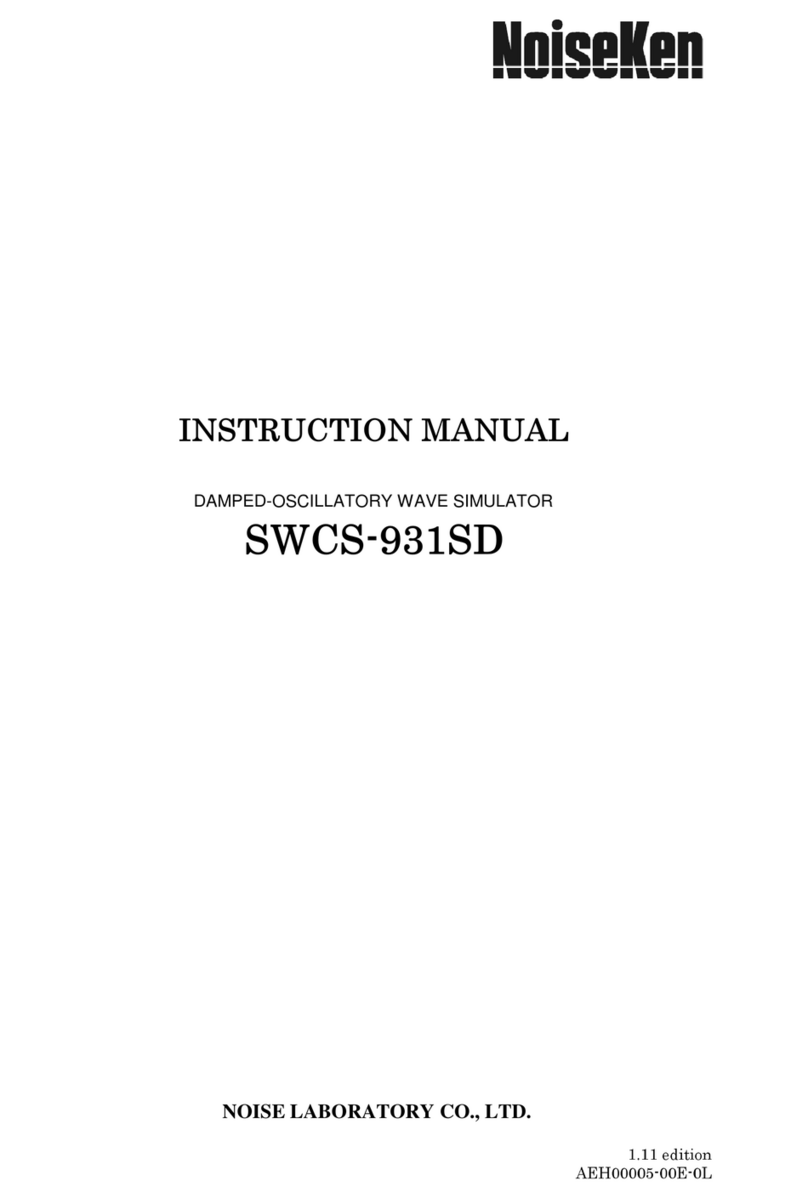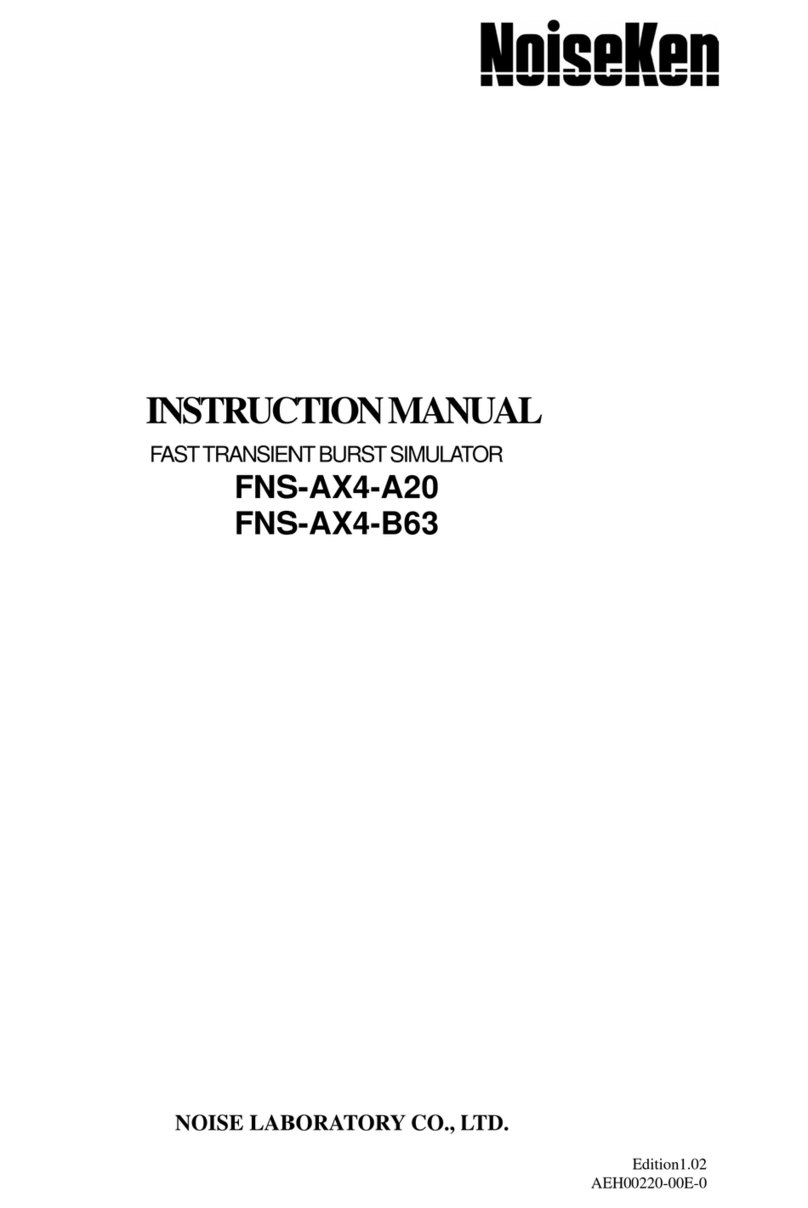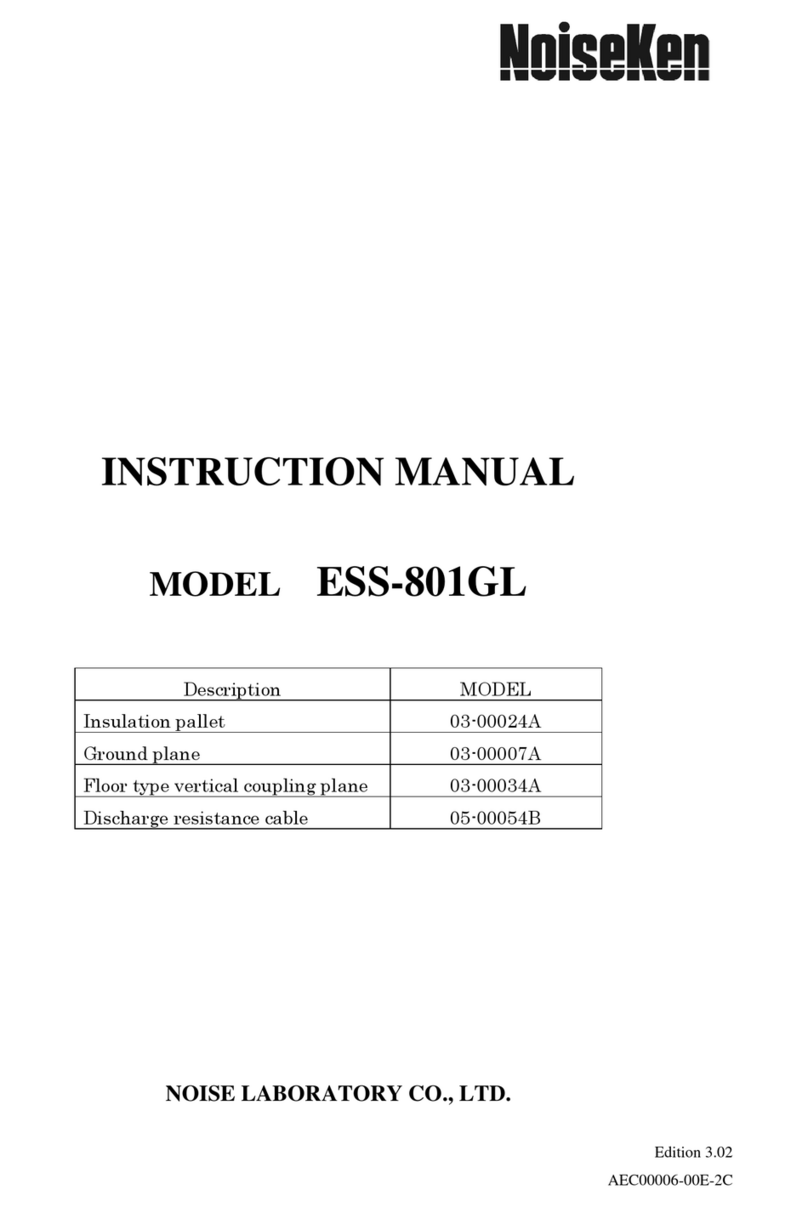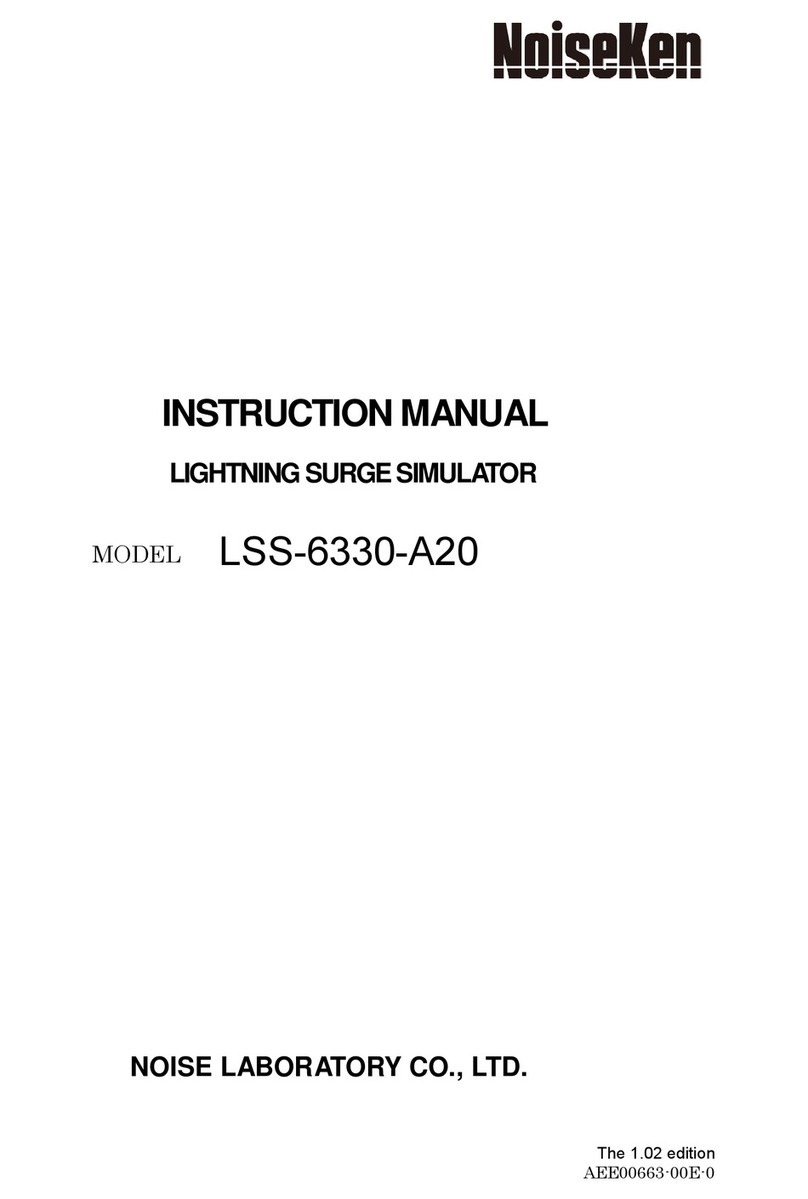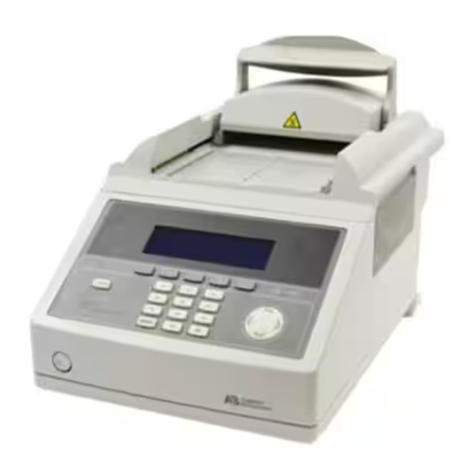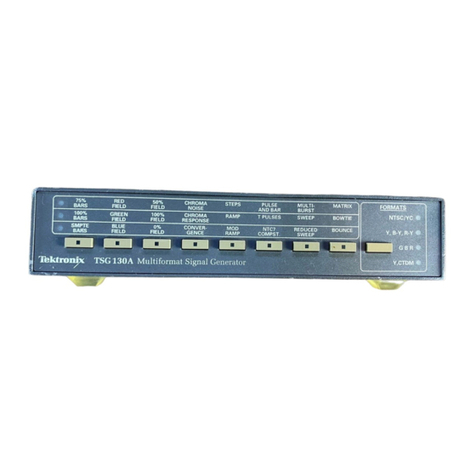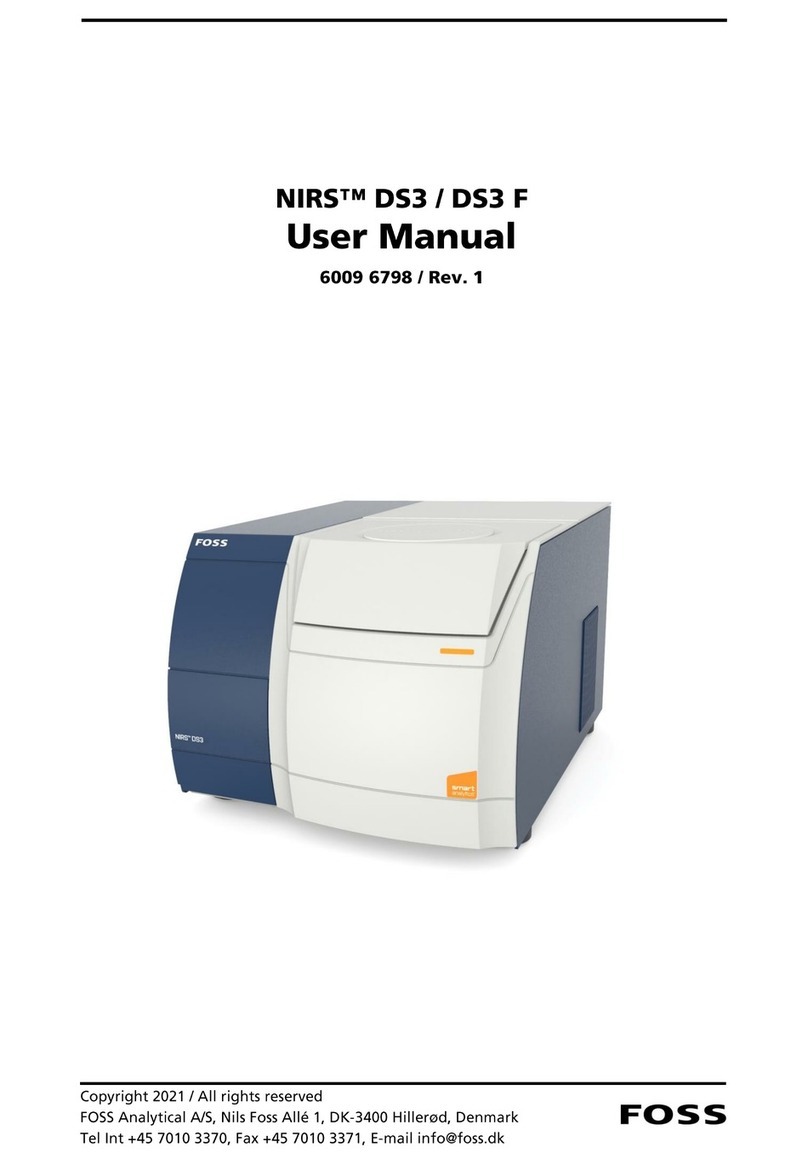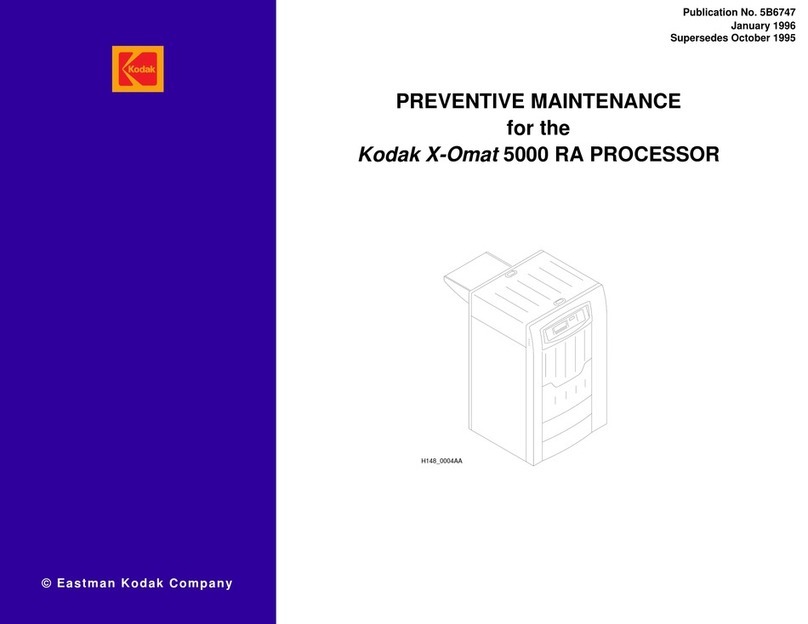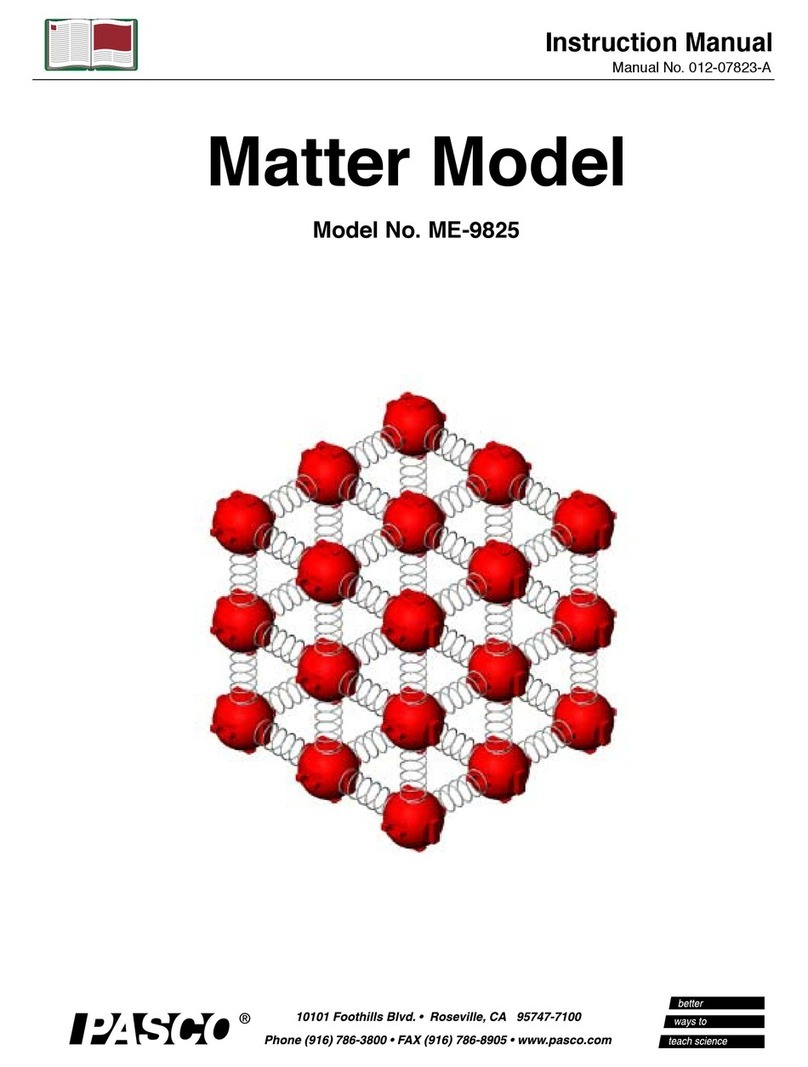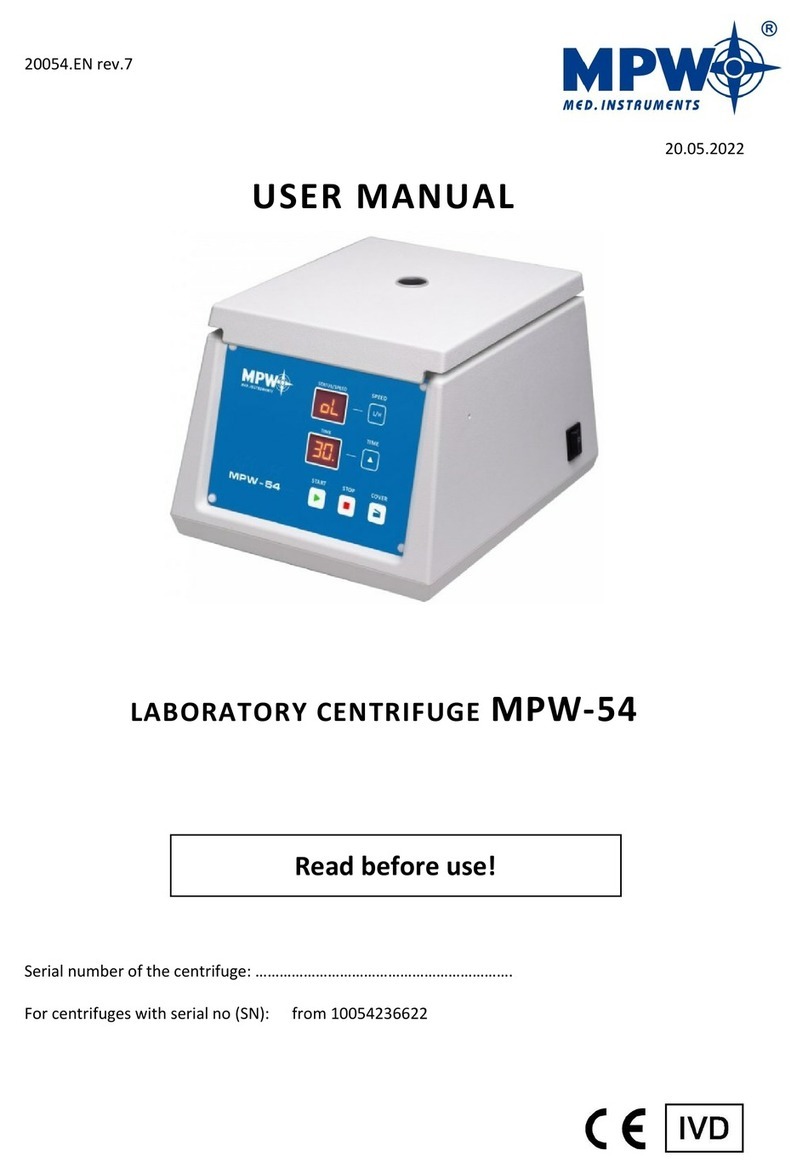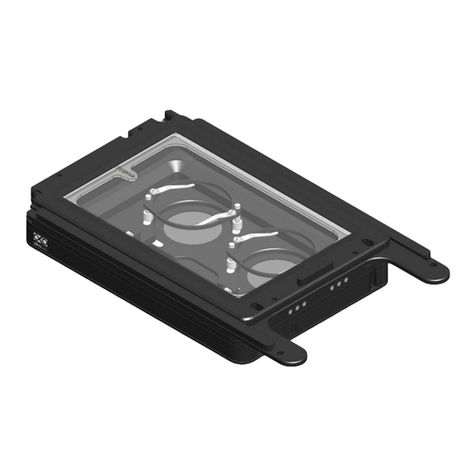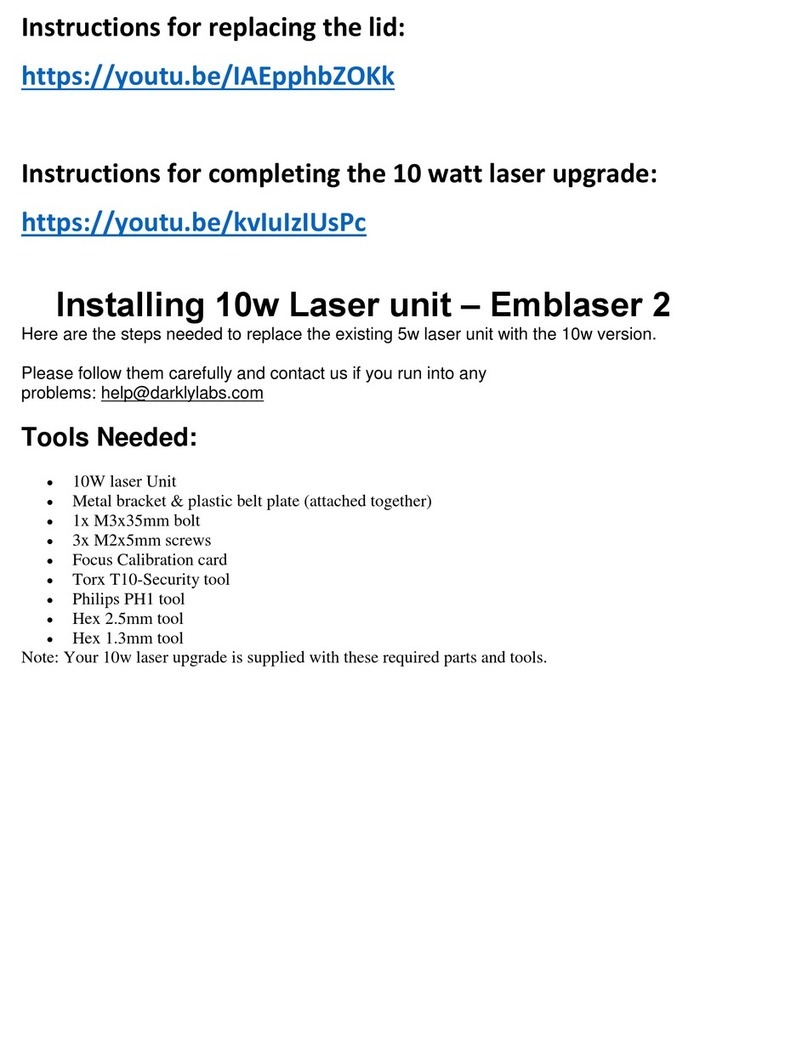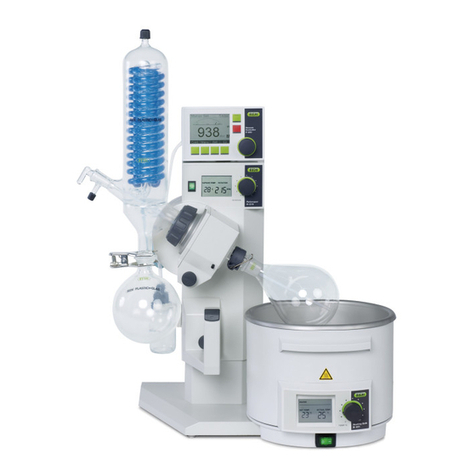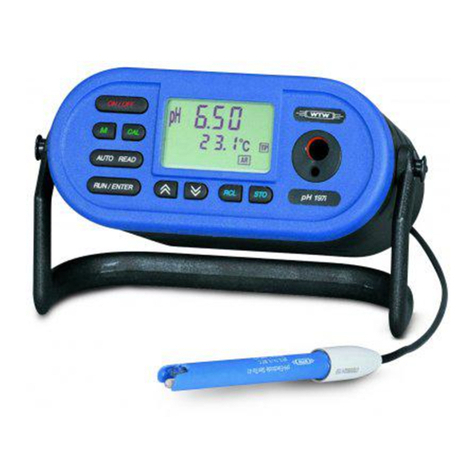NoiseKen LSS-6330-A20A User manual

INSTRUCTION MANUAL
LIGHTNING SURGE SIMULATOR
LSS-6330-A20A
NOISE LABORATORY CO., LTD.
The 1.01 edition
AEE00688-00E-0
MODEL

NOTICE
•The contents of this instruction manual (the “Manual”) are subject to change
without prior notice.
•No part of the Manual may be reproduced or distributed, in any form or by any
means, without the authorization of Noise Laboratory Co., Ltd. (the “Company”).
•The contents of the Manual have been thoroughly examined. However, if you find
any problems, misprints, or missing information, please feel free to contact our
sales agent who you purchased our product from.
•The Company assumes no responsibility for any loss or damage resulting from
improper usage, failure to follow the Manual, or any repair or modifications of this
product undertaken by a third party other than the Company or the agent
authorized by the Company.
•The Company assumes no responsibility for any loss or damage resulting from
remodeling or conversion solely undertaken by the user.
•Please note that the Company cannot be held responsible for any consequences
arising from the use of this product.

1
⚫Only well-trained EMC technicians (electric technicians) are
allowed to use the Unit.
The Unit may cause a fatal wound. Carefully handle it. And it may radiate
electromagnetic noise which exceeds the regulation value. Take applicable
countermeasures such as faraday cage, shield room, etc. as the need arises.
⚫The Unit should be used only for EMC testing described in this
manual.
Using it for other purposes may result in a fatal or serious accident.
⚫A person who has a pacemaker on should not operate the Unit
and also should not enter the area where it is operating.
It may result in a fatal or serious accident.
⚫The Unit cannot be used in an explosive area, fire prohibited
area, etc.
Use of the Unit in such an area is liable to cause combustion or ignition.
1. IMPORTANTSAFETYPRECAUTIONS
The following instructions are very important for safe handling of the lightening surge
simulator LSS-6330-A20A (hereinafter “the Unit”). They must be kept strictly to prevent
users of the Unit from receiving harm or damage through using the Unit. Read them
carefully before use.
A number of safety recommendations are listed in the later chapter
"BASIC SAFETY PRECAUTIONS". Be sure to read them before test
environment settings, connecting relating equipment and testing.

2
2. CHECKPACKAGECONTENTS
Before using the instrument, check whether the included accessories are
complete according to the following list.
A
B
C
D
E
F
G
H
I
J
A:AC cable--------------------------------------------------------------------------------------------- 1
B:Line output cable (1.5m, Plug - M6)---------------------------------------------------------- 3
C:FG cable (2m) (MODEL:05-00070A M6-M6)---------------------------------------- 1
D:Coaxial cable for monitoring (1m) (MODEL:02-00128A BNC-BNC) ---------- 1
E:Interlock connector ------------------------------------------------------------------------------- 1
F:Precheck cable for Surge output terminal (1m, plug - plug) ----------------------------- 1
G:Precheck cable for Line output terminal (1m, plug - plug)------------------------------- 1
H:Line input cable: 1 red, 1black, 1 green/yellow-------------------------------------------- 1 set
I:Surge output cable (1.5m, Plug - Alligator clip)--------------------------------------------- 2
J:Instruction manual--------------------------------------------------------------------------------- 1
K:Accessory bag ------------------------------------------------------------------------------------- 1

3
3. APPLICATIONFORMFORINSTRUCTIONMANUAL
We place an order for an instruction manual.
Model: LSS-6330-A20A
Serial No.:
Applicant:
Company name:
Address:
Department:
Person in charge:
Tel No.:
Fax No.
Cut off this page “APPLICATION FORM FOR INSTRUCTION
MANUAL” from this volume and keep it for future use with
care.
When an INSTRUCTION MANUAL is required, fill in the above Application Form and
mail or fax it to the following sales department of our company.
To: Noise Laboratory Co., Ltd.
1-4-4 Chiyoda, Chuo-ku, Sagamihara City,
Kanagawa Pref., 252-0237 Japan
Tel: +81-(0)42-712-2051 Fax: +81-(0)42-712-2050
Cut
line

MEMO
4

5
4. PREFACE
We thank you very much for your purchase of our Lightening Surge Simulator LSS-6330-
A20A (hereinafter “the Unit”). This instruction manual (“the Manual”) contains how to use
the Unit and other important information. In order to obtain the highest performance from
the Unit, thoroughly understand the contents of the Manual and use as ready reference
for operation.
⚫The Manual was prepared so that any person who can observe the prescribed instruction
method and operating precautions may safely handle and fully utilize the Unit.
⚫Keep the Manual by your side or other proper location so that it may be readily available
when using the Unit.
4-1. Feature
Conforming to IEC61000-4-5 (Edition 3.0 / 2014)
⚫Generating combination wave surge of 1.2/50μs and 10/700μs prescribed by IEC 61000-4-5
(Edition 3 / 2014).
Combination waves mean output of 1.2/50μs or 10/700μs voltage surge waveform with the
surge output unit opened (load: more than 10kΩ) and output of 8/20μs or 5/320μs current
surge waveform with the output unit short-circuited.
⚫Testing high voltage and great electric current (voltage surge: 6.7kV, current surge: 3350A).
The surge generating circuit adopts a floating output system recommended by IEC 61000-4-
5 (Edition 3 / 2014).
⚫Capable to conduct surge injection test to power supply lines with the CDN (Coupling and
Decoupling Network) for EUT which is equipped as standard equipment. The AC/DC line
injection part adopts a circuit system conforming to IEC 61000-4-5 (Edition 3 / 2014).
⚫Generating 0.5μs -100kHz ring wage surge prescribed by IEC61000-4-12. Testing maximum
6.6kV high voltage surge.
User-friendly LCD Control Panel
⚫The operation panel adopts a color LCD touch panel for pursuing high visibility.
⚫Capable of various kinds of setup with simple touch panel.
⚫Employs push buttons for handling safety-related operation such as START/STOP.
Various Functions Broaden Horizons of Test
⚫Preset test conditions which are prescribed on the standard in the “standard test” mode.
⚫Capable to set test conditions as you like in the “manual test” mode.
⚫“Sweep” function enable automatic step-by-step change of test parameters.
⚫Capable to save your test conditions.
⚫Remote control is available with optical communication (optional).

6
5. CONTENTS
1. IMPORTANT SAFETY PRECAUTIONS................................................................................................... 1
2. CHECK PACKAGE CONTENTS.................................................................................................................2
3. APPLICATION FORM FOR INSTRUCTION MANUAL.......................................................................3
4. PREFACE............................................................................................................................................................ 5
4-1. Feature .............................................................................................................................................................................................5
5. CONTENTS........................................................................................................................................................6
6. BASIC SAFETY PRECAUTIONS ............................................................................................................... 8
6-1. Symbols of Hazard.......................................................................................................................................................................8
6-2. Symbols of Instruction, Warning and Caution ..................................................................................................................8
6-3. Danger............................................................................................................................................................................................ 10
6-4. Warning .......................................................................................................................................................................................... 10
6-5. Caution .......................................................................................................................................................................................... 12
7. CAUTION ABOUT EXPENDABLE SUPPLIES ....................................................................................14
8. INTRODUCTORY NOTES...........................................................................................................................15
8-1. Introductory Notes ................................................................................................................................................................... 15
8-2. Terms and Definitions ............................................................................................................................................................. 15
8-3. Definition of Surge Waveform .............................................................................................................................................. 16
8-4. Block Diagram............................................................................................................................................................................. 17
9. APPEARANCE AND FUNCTION OF EACH PART ...........................................................................18
9-1. Appearance of The Main Unit .............................................................................................................................................. 18
9-2. Front Panel .................................................................................................................................................................................. 19
9-3. Rear Panel.................................................................................................................................................................................... 21
10.CONNECTION.................................................................................................................................................23
10-1. Connecting AC Cord................................................................................................................................................................ 23
10-2. Connection of Optical Communication Cable (Optional) ......................................................................................... 24
10-3. Connection for Applying Surge Waveform to EUT Directly.................................................................................... 24
10-4. Connection for Applying Surge Waveform to AC/DC Line..................................................................................... 25
11.OPERATION ....................................................................................................................................................27
11-1. Power ON unit............................................................................................................................................................................ 27
11-2. Emergency Stop Button......................................................................................................................................................... 27
11-3. Main Menu .................................................................................................................................................................................... 28
11-4. Screen Flowchart...................................................................................................................................................................... 29
11-5. Inputting Numbers and Letters (About Ten Key and Character Key) ............................................................... 30
12.STANDARD TEST .........................................................................................................................................31
12-1. Setting Standard Test............................................................................................................................................................. 31

CONTENTS
7
12-2. AC LINE Standard .................................................................................................................................................................... 33
12-3. DC LINE Standard .................................................................................................................................................................... 34
12-4. ENCLOSURE Standard........................................................................................................................................................... 34
12-5. Executing Standard Test ....................................................................................................................................................... 35
13.MANUAL TEST .............................................................................................................................................. 40
13-1. Setting Manual Test................................................................................................................................................................. 40
13-2. Setting AC/DC Injection........................................................................................................................................................ 47
13-3. Executing Manual Test ........................................................................................................................................................... 51
14.TITLE SAVE / LOAD .................................................................................................................................. 55
15.UTILITY............................................................................................................................................................. 58
16. PHASE ANGLE CORRECTION ................................................................................................... 62
17.PRE CHECK.................................................................................................................................................... 64
18. ERROR MESSAGE............................................................................................................................. 66
19.SPECIFICATIONS......................................................................................................................................... 67
19-1. General specifiactions............................................................................................................................................................. 67
19-2. Surge Generating Part ............................................................................................................................................................ 68
19-3. AC / DC Line Injection Part ................................................................................................................................................ 69
20.OPTIONAL PRODUCT................................................................................................................................ 70
21.WAVEFORM VERIFICATION .................................................................................................................... 71
21-1. Preparation .................................................................................................................................................................................. 71
21-2. Connection................................................................................................................................................................................... 71
21-3. Measurement .............................................................................................................................................................................. 72
21-4. Why PE of Oscilloscope Should Not be Common with Earth of the Unit......................................................... 72
22.WARRANTY..................................................................................................................................................... 73
23.MAINTENANCE.............................................................................................................................................. 75
24.NOISE LABORATORY SUPPORT NETWORK ................................................................................... 76

8
6. BASICSAFETYPRECAUTIONS
⚫The following items are very important instructions which users must follow to take
precautions against possible injury and harm.
⚫The indications are provided as an explanation of potential danger involved if the
safety precautions are not observed correctly.
6-1. Symbols of Hazard
◆The following display classifications describe degree, to which injury or harm might occur
when the contents of the display are not followed or the Unit or related equipment is operated
incorrectly.
DANGER
The contents of this display indicate “the assumption that imminent danger might occur
resulting in death or serious injury” if the Unit or related equipment is handled
incorrectly.
WARNING
The contents of this display indicate “the assumption that there is a possibility of death
or serious injury” if the Unit or related equipment is handled incorrectly.
CAUTION
The contents of this display indicate “the assumption that there is a possibility of harm
and the assumption that there is a possibility of physical damage” if the Unit or related
equipment is handled incorrectly.
6-2. Symbols of Instruction, Warning and Caution
◆The following display classifications describe details that should be followed.
Indicates attention (a matter that must be
paid attention fully)
Indicates prohibition (an action that must
not be taken)
Do not
disassemble
Indicates a compulsory action (an action
that must be taken)

BASIC SAFETY PRECAUTIONS
9
Noticing possibility of an electric shock
It indicates that there is possibility of an electric shock.
Noticing caution, warning and danger
It indicates that there is a possibility of harm or physical
damage if the Unit is or related equipment is handled
incorrectly and that the Manual should be referred.
It indicates warnings for electric shock etc. and the
Manual should be referred.
Notifying danger of electric shock and the Manual
should be referred.
Warning
To reduce the risk of electric shock, do not remove
cover.
Notifying danger of electric shock and the Manual
should be referred.
Caution in handling
Noise Laboratory Co., Ltd. is excluded all the liability of
any forms of damage, of equipment or humans, caused
by user’s mishandling during operation.
Notifying danger of electric shock and the Manual
should be referred.
Caution in handling
SOCKET WITH LOCK
PUSH AND THEN PULL OUT
Notifying danger of electric shock and the Manual
should be referred.
Caution in handling
Lifting may damage back.

BASIC SAFETY PRECAUTIONS
10
6-3. Danger
Do not
disassemble
Do not take the Unit apart or remodel. Do not open the cover.
Imminent danger might occur resulting in death or serious injury. Repair, internal
adjustment, and inspection of the Unit should be performed by a qualified service
engineer. Ask the Company or its sales agent.
Do not use the Unit in an explosive are or fire-prohibited area etc.
Use of the Unit in such an area is liable to cause combustion or ignition.
A person who has a pacemaker on should not operate the Unit and also
should not enter the area where it is operating.
It may result in a fatal or serious accident.
6-4. Warning
Stop operation if following unusual phenomena should occur.
Emitting fumes, or smelling.
Water or an unusual substance being stuck
Being dropped or being damaged
AC cable being damaged (e.g. core lines being exposed etc.)
Continuing to operate in the above status may result in a fire, electric shock, or injury.
If an unusual phenomenon occurs, turn off power supply immediately, pull AC plug out
of an outlet, and ask the Company or sales agent repair. As there is potential danger,
any user must not repair the product.
Insulate and protect the test facility against maximum output voltage of
the Unit.
If the test facility is not so insulated and protected, there is the dangerous possibility
of an electric shock, leak or fire.
Turn off power supply of the Unit when setting or changing connection
of related equipment.
Failure to follow this notice may cause electric shock, injury, or malfunction.
Fully pay attention to insulation of surge return route also.
The surge generating circuit of the Unit adopts floating system. Since the return route
is not connected to the chassis, high voltage may generate on the return route.
Use the Unit after understanding instructions in the Manual fully.
There may be danger causing a fatal or serious wound or emitting over-ristricted-value
electromagnetic noise in using the Unit. NOISE LABORATORY and its sales agents
shall have no liability against any accident resulting in injury or death, any damage to
equipment or any resultant damage thereof, which is caused by abuse or careless
handling of this unit.

BASIC SAFETY PRECAUTIONS
11
Watch equipment while the Unit is operating.
If this instruction should not be followed, a third person or equipment related to the
test may be exposed to a danger.
Supply power within the indicated range (AC100 V~240 V).
The misuse may cause an electric shock or a fire. The attached AC cord in the
accessory is for AC100~120 V. Prepare a proper 3-line AC cord with a protective earth
pin conforming to the local safety standard in using with AC220~240 V power supply.
Use proper connectors and cables and connect them securely.
Avoid using a damaged connector or cable. The misuse may cause an electric shock
or damage of equipment.
Insert AC plug securely to the end.
Insecure inserting generates heat and gathers dust. It may result in a fire or an electric
shock. Avoid using a multiple outlet extension plug for the same reason.
Install the Unit on a stable place.
If the Unit is installed on an unstable place, human body may be in danger due to drop
or overturn of the Unit.
Connect the protective earth of AC cord.
Using the Unit without connecting it may cause an electric shock.
Be sure to insert an isolation transformer between LINE IN of the Unit
and AC LINE power supply for AC LINE Injection test.
If AC LINE power is supplied to the Unit directly, a circuit breaker installed on the
power supply may function due to leak current from the Unit.
Do not use the Unit for any other purpose than Surge test.
The misuse may result in an electric shock, an injury, or damage of equipment.
Do not put any substance into the Unit or its connectors.
If some metal or flammable things are put into the Unit through a connector or a vent,
it may result in a fire or an electric shock.
Do not use the attached AC cord for any other purpose.
The misuse may result in a fire or an electric shock.
Do not install the Unit on the spot where quick operation of power key or
STOP key is difficult.
If the simulator is set up on such a spot, difficulty in taking action in emergency may
result in a fire or an electric shock.

BASIC SAFETY PRECAUTIONS
12
Do not damage AC cord.
A damaged AC cord may cause a fire or an electric shock.
For HV cable, be sure to take notice following points.
Do not work it.
Do not bend it forcibly.
Do not twist it.
Do not pull it.
Do not move it close to heat.
Do not put heavy things on it.
6-5. Caution
Take actions against emission of electromagnetic waves.
When a test is performed using the Unit, a great amount of electromagnetic waves are
emitted according to the type of EUT, sometimes adversely affecting the neighboring
electronic equipment and radio communication apparatus. The user is required to
provide a Faraday gage, shield room, shielding cable, etc. as necessary.
Do not connect an AC/DC power line to SURGE OUT terminal directly.
Connecting the power line directly damages the internal unit.
If dewing occurs, fully dry up the Unit before using it.
Dews may cause an electric shock, a trouble, a fire.
Use the Unit in proper environment.
Operating temperature range is 15~35℃. Operating humidity range is 25~75%. If
these precautions are not followed, the unit may be broken or the prescribed
performance may not be warranted.
Clean up the AC plug periodically.
If dust gets damp between the AC plug and outlet, insulation capability deteriorates. It
may result in a fire. Pull the AC plug out from an outlet periodically and wipe it with a
dry cloth.
When the body is dirty, wipe the body with a dry cloth.
Do not wipe the Unit and Probe with thinner, alcohol or other solvent.
When the body is very dirty, soak a cloth into neutral detergent, squeeze out the
detergent from the cloth and wipe the body with the cloth.
Make hazardous labels always noticeable.
When the caution or warning label is peeled off, missing or dirty, attach a new one for
securing safety. When the caution or warning label is missing, ask the sales
department or maintenance section of our company to send a new label.

BASIC SAFETY PRECAUTIONS
13
Do not work alone when moving the installation.
This unit is heavy. When moving the installation site, take safety measures by multiple
people.
Do not install the Unit on following places.
Setting up the Unit on wrong places as follows may result in a fire, an electric shock,
or an injury.
A very humid or dusty place
A hot place, e.g. a place exposed to direct rays of the sun, a place close to
a heater.
A place easy to bedew, e.g. a place close to a window.
Do not block a vent or do not use the Unit in a place poorly ventilated.
If a vent is blocked, the internal heat is close. It may cause a fire. For ventilation, be
sure to take notice following points.
Do not lay the Unit on its back, sideways, or upside down.
Do not put the Unit into a small, poorly ventilated place.
Keep the Unit at least 10cm away from a wall or some substance.
Do not handle the AC plug with your hand wet.
The misuse may result in an electric shock or trouble.
Do not operate LCD panel with something sharp or pointed.
The misuse may result in damage of the touch panel.
Do not drop or shock the Unit excessively.
The misuse may cause trouble or damage.
Do not bump or rub the Unit against something hard.
The misuse may damage a surface of the Unit.
Do not put any heavy thing or sit on the Unit.
The misuse may result in a dent on the body or damage of internal components.

14
7. CAUTIONABOUTEXPENDABLESUPPLIES
⚫About a high voltage relay inside
A high voltage relay used inside is an expendable component.
The lifetime of it is dependent on using conditions and environment.
If a symptom which seems to be caused by an exhausted high voltage relay, e.g. unstable
current value, unstable repetition cycle or so on, is found, contact Noise Laboratory or your
closest sales agent of Noise Laboratory. Repair by a user is impossible.
⚫Fuse
The instrument contains fuses.
The fuse holder is located in the AC inlet and the fuse can be replaceable is user.
Please replace with a fuse of the following type.
If unable to obtain the correct fuse, please contact your sales agent or the Noise Laboratory
Customer Service Center.
Fig 7-1. Fuse Box
Rated voltage 250V/ Rated current 3.15ASlo-Blo type
Recommended Fuse:Littelfuse 2153.15MXP
Quantity:2
Fuse box
Pull to OPEN
In the event of failure in normal usage, repair shall be performed under the condition of the
warranty rule. However, NOISE LABORATORY and its sales agents shall not be liable for
any accident resulting in damage of DUT or peripheral equipment caused by deterioration
of performance of expendable parts or any other external factors.

15
8. INTRODUCTORYNOTES
8-1. Introductory Notes
The meaning of following symbols is as follows.
Operate the touch panel.
Additional explanation.
Indicating other parts to be referred in the Manual.
Indicating restriction of setting up.
Indicating items to be confirmed before usage.
【】
Indicating text on the panel of the Unit.
『』
Indicating text on the LCD of the Unit.
8-2. Terms and Definitions
The terms and their definitions are shown as follows.
Term
Definition
Surge
Transient wave of electrical voltage, current, or power, propagating
along a line or a circuit. It is a single waveform characterized by a rapid
increse followed by a slower decrease. The phenomenon occurs
sometimes by lightening, sometimes by transient response of
switching of a circuit.
Voltage surge
Surge which waveform is fromed in as voltage. With this simulator, this
waveform is defined as a voltage waveform which is observed when
some load (EUT odr DUT) is connected to the output including when
the output is open.
Current surge
Surge which waveform is fromed in as voltage. With this simulator, this
waveform is defined as a current waveform which is observed when
some load (EUT or DUT) is connected to the output including when the
output is short-circuited.
Front time
Parameter defining rise time of surge waveform. Each of voltage surge
and current surge has its own definition of front time.
Duration
Time interval between the instant at which the rise time to 50% of surge
peakvalue, and then falls to 50% of its peak value
Output impedance
Effective output impedance of the surge generating circuit. The
following formula is used to acquire it.
(Peak voltage value in open) / (Peak current value in short-circuired)
DUT
Device Under Test. A device to be tested by test equipment.
EUT
Equipment Under Test. Equipment to be tested by test equipment.

INTRODUCTORY NOTES
16
8-3. Definition of Surge Waveform
Voltage Surge Waveform
Fig 8-1 Voltage surge waveform
Front time (T1): 1.67 times of the interval of time between the instants when the voltage value
increases to 30% and 90% of the peak value.
Duration (T2): Time interval between the instant at which the surge voltage rises to 0.5 of its peak
value, and then falls to 0.5 of its peak value
Fig 8-2 RINGWAVE Voltage waveform
Front time (T1)::Time interval between the instants when the voltage value increases to 10% and
90% of the peak value
Oscillation period(T): The reciprocal of the time between the zero-cross point after the first peak and
the zero-cross after the third peak.
Current Surge Waveform
Fig 8-3 Current surge waveform
Front time (T1): 1.25 times of the interval of time between the instants when the current value
increases to 10% and 90% of the peak value.
Duration (T2): virtual parameter defined as the time interval between the instant at which the surge
current rises to 0.5 of its peak value, and then falls to 0.5 of its peak value (Tw) for 5/320uS waveform,
and multiplied by 1.18 for 8/20uS waveform

INTRODUCTORY NOTES
17
8-4. Block Diagram
HVPS:High voltage power supply , RL1:Elimination relay
S1:Surge Switch , C1~C3:Surge Capacitor
SW operation
Turn ON in 1.2/50us surge :SW2,SW7,SW8
Turn ON in 10/700us surge :SW1,SW2,SW9,SW11,SW16,SW17
Turn ON in RINGwave surge :SW3,SW4,SW6
(SW5:RING124 in ON)
Coupling capacitor:C5
~
C8 , Coupling resistor
:R10
Decoupling inductance:L4,L5 , Decoupling capacitor:C9~C11
Turn ON in positive surge polarity:SW12,SW13
Turn ON in negative surge polarity:SW14,SW15
Turn ON in Coupling network 18uF:SW16,SW18,SW19,SW20
Turn ON in Coupling network 9uF+10Ω:SW18,SW20

18
9. APPEARANCEANDFUNCTIONOFEACHPART
9-1. Appearance of The Main Unit
Front Panel
Rear Panel
Table of contents
Other NoiseKen Laboratory Equipment manuals

NoiseKen
NoiseKen LSS-6330TEL User manual

NoiseKen
NoiseKen JSS-003 User manual

NoiseKen
NoiseKen IJ-4050 User manual
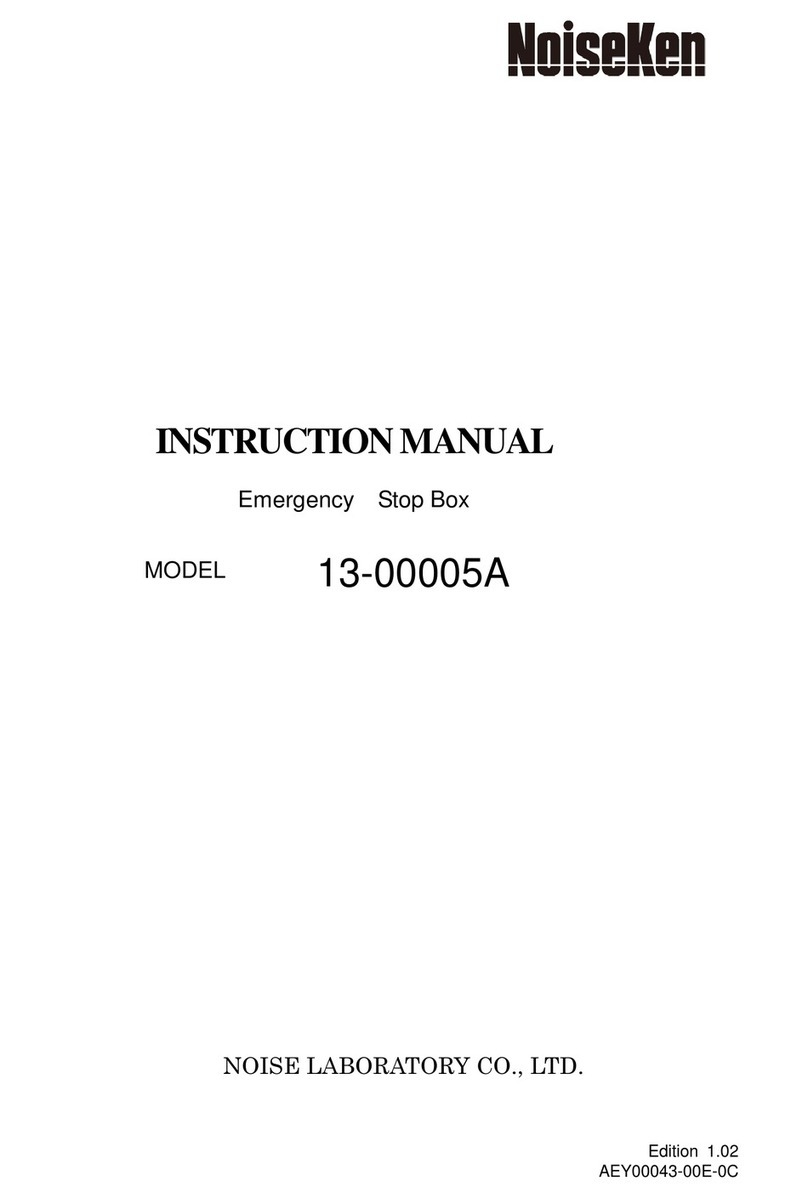
NoiseKen
NoiseKen 13-00005A User manual
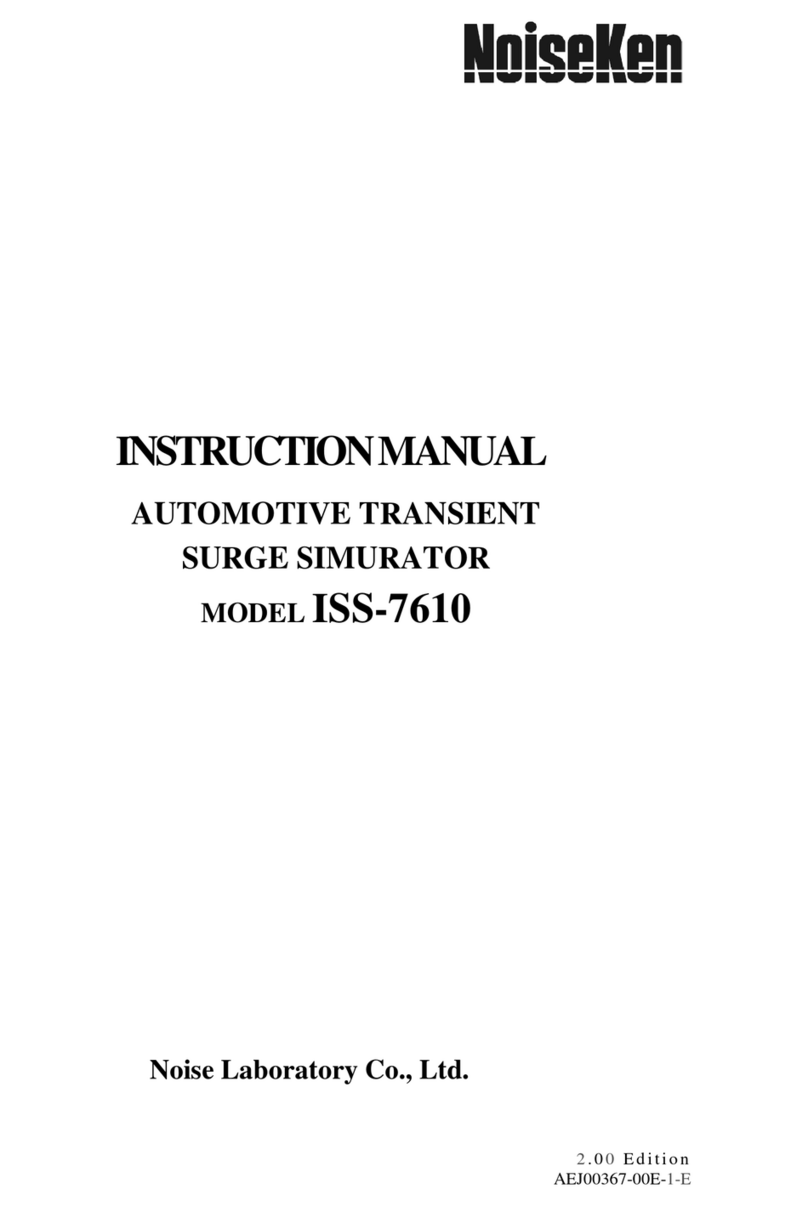
NoiseKen
NoiseKen ISS-7610 User manual
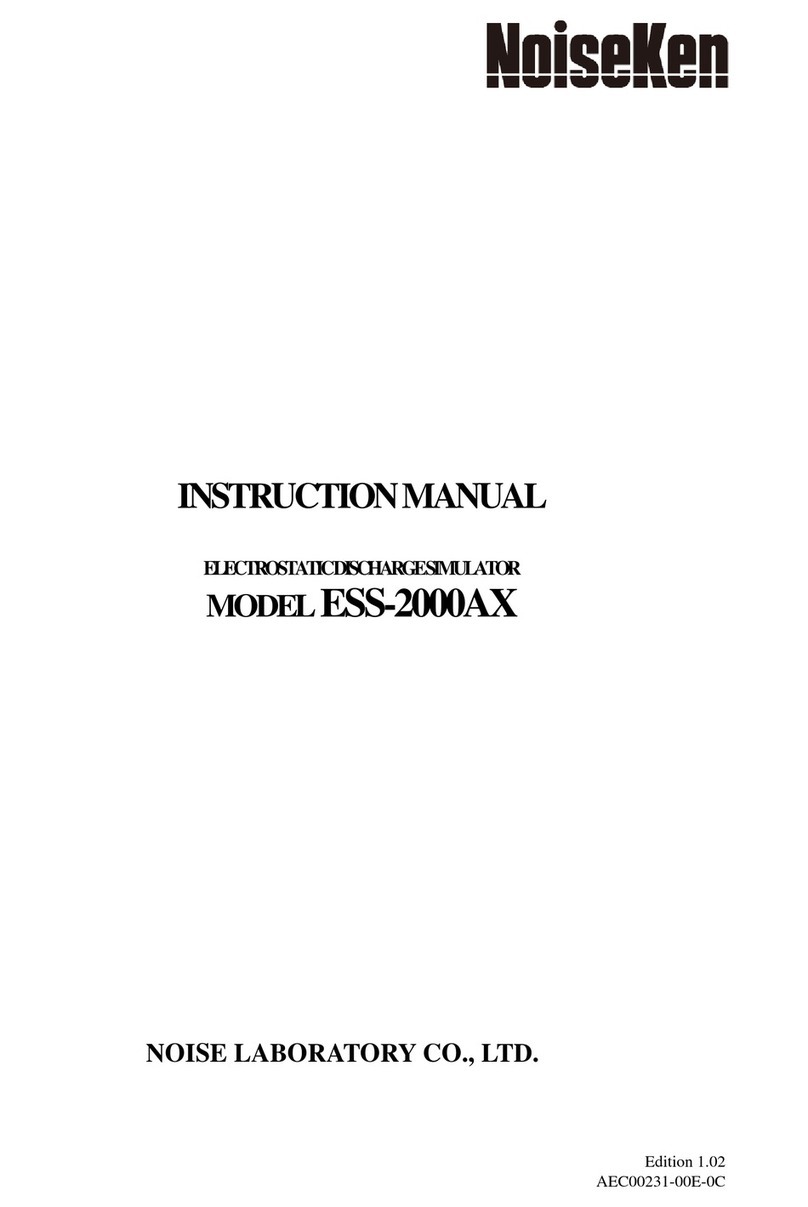
NoiseKen
NoiseKen ESS-2000AX User manual
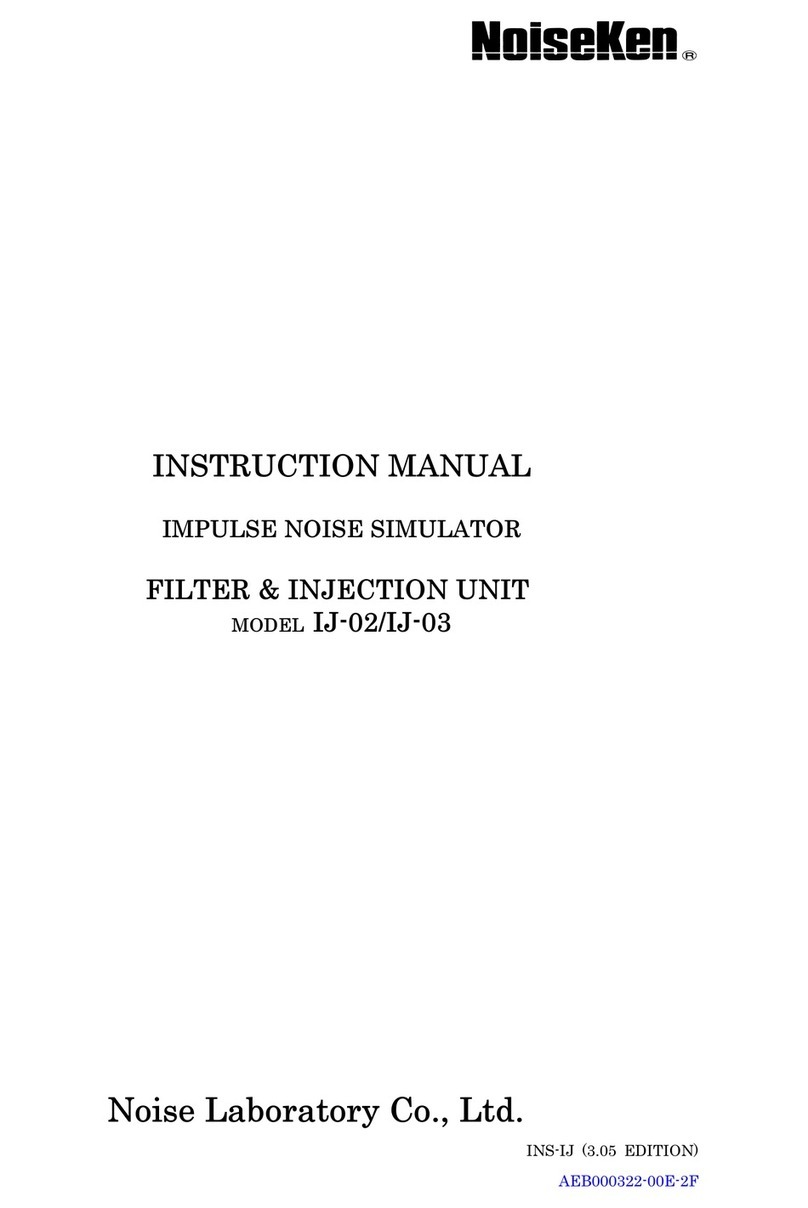
NoiseKen
NoiseKen IJ-02 User manual
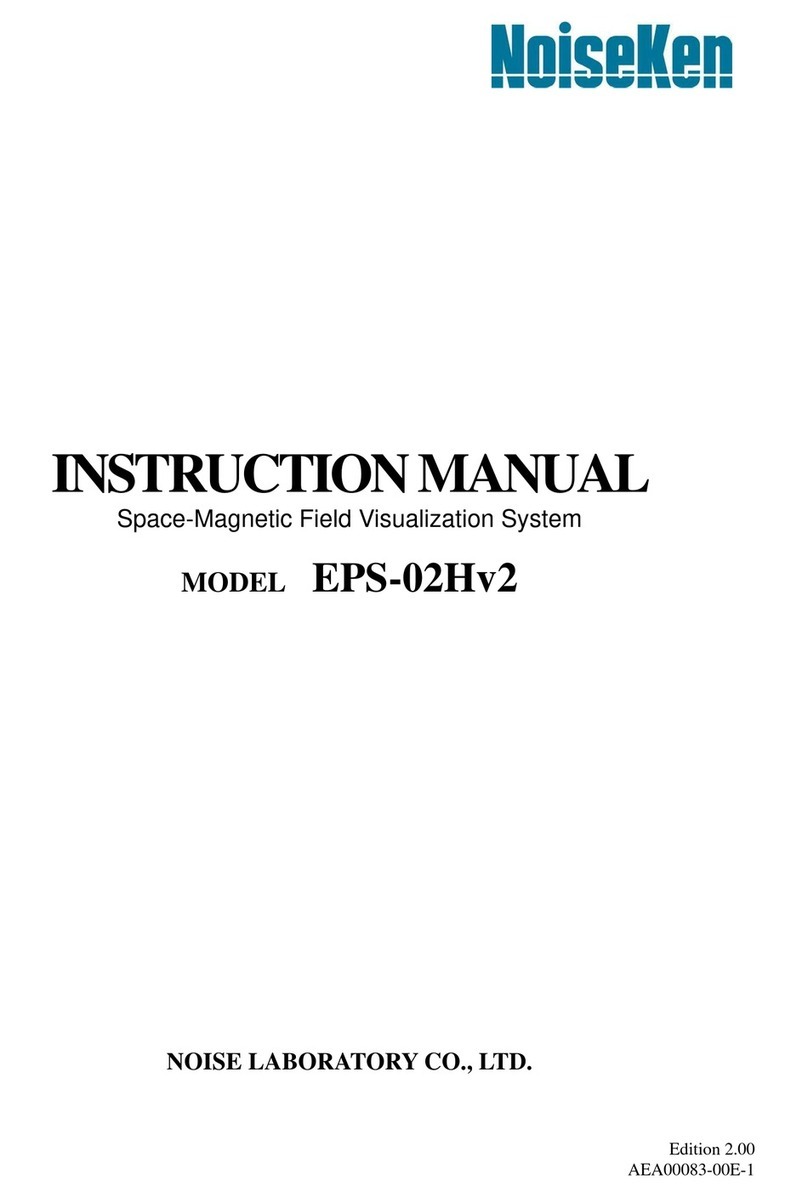
NoiseKen
NoiseKen EPS-02Hv2 User manual

NoiseKen
NoiseKen LSS-6330-B63A User manual

NoiseKen
NoiseKen ESS-S3011A User manual

